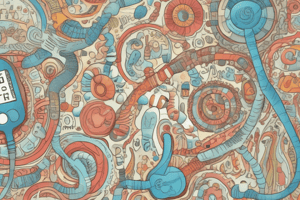Podcast
Questions and Answers
Which of the following best describes the primary metabolic abnormalities associated with Type 2 Diabetes Mellitus?
Which of the following best describes the primary metabolic abnormalities associated with Type 2 Diabetes Mellitus?
- Insulin resistance in peripheral tissues, inadequate insulin secretion by pancreatic beta cells, and abnormal glucose release by the liver. (correct)
- Increased glucose uptake by adipose tissue and decreased cytokine release, leading to reduced inflammation.
- Insulin sensitivity in peripheral tissues coupled with suppressed glucose production by the liver.
- Excessive insulin secretion by pancreatic beta cells, leading to hypoglycemia and increased glucose uptake by the liver.
A 50-year-old individual with a family history of diabetes and a sedentary lifestyle is diagnosed with hypertension. How does hypertension contribute to the risk of developing Type 2 Diabetes in this individual?
A 50-year-old individual with a family history of diabetes and a sedentary lifestyle is diagnosed with hypertension. How does hypertension contribute to the risk of developing Type 2 Diabetes in this individual?
- Hypertension directly impairs the function of insulin receptors, leading to decreased glucose uptake in cells.
- Hypertension causes increased blood flow to the pancreas, resulting in excessive insulin production and eventual beta-cell exhaustion.
- Hypertension leads to vasoconstriction, reducing perfusion to the pancreas and potentially causing pancreatic dysfunction. (correct)
- Hypertension promotes increased glucose absorption in the intestines, leading to hyperglycemia and insulin resistance.
Which clinical feature is most indicative of the gradual onset of Type 2 Diabetes Mellitus?
Which clinical feature is most indicative of the gradual onset of Type 2 Diabetes Mellitus?
- Abrupt onset of ketoacidosis requiring immediate medical intervention.
- Progressive development of the '3 Ps' (polydipsia, polyuria, polyphagia) over several weeks.
- Asymptomatic hyperglycemia detected during routine medical check-ups. (correct)
- Sudden and severe hyperglycemia accompanied by rapid weight loss.
How does adipose tissue contribute to the pathophysiology of Type 2 Diabetes Mellitus?
How does adipose tissue contribute to the pathophysiology of Type 2 Diabetes Mellitus?
An individual with a history of gestational diabetes is considered to have what kind of risk factor for developing Type 2 Diabetes Mellitus later in life?
An individual with a history of gestational diabetes is considered to have what kind of risk factor for developing Type 2 Diabetes Mellitus later in life?
Why does blurry vision occur as a complication of diabetes?
Why does blurry vision occur as a complication of diabetes?
Which macrovascular complication of diabetes increases the likelihood of myocardial infarction?
Which macrovascular complication of diabetes increases the likelihood of myocardial infarction?
Why are individuals with diabetes prone to recurrent infections?
Why are individuals with diabetes prone to recurrent infections?
What is the primary reason for administering IV fluids to a patient experiencing Hyperosmolar Hyperglycemic State (HHS)?
What is the primary reason for administering IV fluids to a patient experiencing Hyperosmolar Hyperglycemic State (HHS)?
Why is moderate physical activity recommended as a lifestyle modification for individuals with diabetes?
Why is moderate physical activity recommended as a lifestyle modification for individuals with diabetes?
Why is it important for individuals with diabetes to avoid wearing open-toe sandals?
Why is it important for individuals with diabetes to avoid wearing open-toe sandals?
During sick days, why should individuals with diabetes continue taking insulin as directed, even if they are not eating?
During sick days, why should individuals with diabetes continue taking insulin as directed, even if they are not eating?
An unconscious patient with a history of diabetes presents with the following symptoms: blood glucose > 600 mg/dL, severe dehydration and no ketones in urine. Which condition is most likely?
An unconscious patient with a history of diabetes presents with the following symptoms: blood glucose > 600 mg/dL, severe dehydration and no ketones in urine. Which condition is most likely?
Flashcards
Type 2 Diabetes Mellitus
Type 2 Diabetes Mellitus
Body doesn't make enough insulin or insulin doesn't work properly, pancreas makes some insulin but not enough.
Insulin Resistance/Inadequate Secretion
Insulin Resistance/Inadequate Secretion
Insulin receptors aren't working right, not enough insulin is produced, or both, leading to hyperglycemia as glucose remains in the blood.
Liver Abnormality in Type 2 Diabetes
Liver Abnormality in Type 2 Diabetes
Liver releases too much glucose into the blood, worsening hyperglycemia.
Adipose Tissue Role in Type 2 Diabetes
Adipose Tissue Role in Type 2 Diabetes
Signup and view all the flashcards
Polydipsia
Polydipsia
Signup and view all the flashcards
Polyphagia
Polyphagia
Signup and view all the flashcards
Blurry Vision (in Diabetes)
Blurry Vision (in Diabetes)
Signup and view all the flashcards
Macrovascular Complications
Macrovascular Complications
Signup and view all the flashcards
Microvascular Complications
Microvascular Complications
Signup and view all the flashcards
Hyperosmolar Hyperglycemic State (HHS)
Hyperosmolar Hyperglycemic State (HHS)
Signup and view all the flashcards
Severe Polyuria in HHS
Severe Polyuria in HHS
Signup and view all the flashcards
Low Fat, High Fiber Diet
Low Fat, High Fiber Diet
Signup and view all the flashcards
Daily Foot Inspection
Daily Foot Inspection
Signup and view all the flashcards
Study Notes
- Type 2 Diabetes Mellitus arises when the body doesn't produce enough insulin or cannot use insulin effectively, despite the pancreas still producing some insulin.
Metabolic Abnormalities
- Insulin resistance or inadequate insulin secretion from pancreatic beta cells results in the insulin receptors not functioning properly and/or insufficient insulin production, preventing glucose from entering cells and causing hyperglycemia.
- Liver abnormality means the liver responds erratically to blood glucose levels, releasing too much or too little glucose.
- Adipose tissue releases cytokines, leading to chronic inflammation associated with Type 2 diabetes.
Risk Factors
- Non-modifiable risk factors include being at least 45 years old, having a family history of diabetes, or a history of gestational diabetes.
- Modifiable risk factors, often linked to adipose tissue, include being overweight or obese, physical inactivity, hyperlipidemia, hypertension (vasoconstriction reduces pancreatic perfusion leading to dysfunction), and cigarette smoking (causing inflammation and vasoconstriction).
Clinical Features
- Type 2 diabetes typically has a gradual onset and may present with asymptomatic hyperglycemia.
- The "3 Ps" of diabetes:
- Polydipsia (increased thirst)
- Polyuria (frequent urination)
- Polyphagia (excessive hunger), are caused by high glucose levels and the osmotic gradient pulling water into the bloodstream.
- Blurry vision can occur as high blood sugar damages the lenses of the eyes.
Diagnostic Criteria
- Hemoglobin A1C level of 6.5% or higher indicates diabetes.
- Fasting glucose level of 126 mg/dL or higher is a diagnostic criterion.
- Random glucose level of 200 mg/dL or higher, along with hyperglycemia symptoms, points to diabetes.
- Oral glucose tolerance test is used for diagnosis during pregnancy.
Complications
- Macrovascular complications of atherosclerosis include coronary artery disease, stroke/transient ischemic attack, and peripheral artery disease.
- Microvascular complications affect small blood vessels, leading to peripheral neuropathy (due to poor circulation), retinopathy, nephropathy, delayed wound healing, and recurrent infections.
Hyperosmolar Hyperglycemic State (HHS)
- HHS is a life-threatening condition with gradual onset.
- The pancreas produces enough insulin to prevent ketoacidosis, with no ketones present in the urine.
- Severe hyperglycemia leads to dehydration as water is drawn out of cells due to concentrated blood.
- Clinical Features: Blood glucose levels are typically > 600 mg/dL, usually triggered by underlying infection, medication, or acute/chronic illness, and severe polyuria leads to dehydration
- Neurologic manifestations include blurry vision, lethargy, altered level of consciousness, and potentially coma.
- Treatment Goals: Lower glucose levels to within normal limits; administer IV fluids, insulin, and electrolytes to correct severe dehydration.
Lifestyle Modifications
- Engage in moderate activity to reduce insulin resistance, blood pressure, and cholesterol.
- Follow a low-fat, high-fiber diet with a low glycemic index.
- Reduce weight if the client is obese.
- Avoid alcohol consumption due to the risk of hypoglycemia.
- Use oral antidiabetic medications as prescribed
- Consider prescribed insulin if oral medications are insufficient.
- Treat hyperlipidemia with statins, if necessary.
- Monitor regularly for hyperglycemia and HHS.
Proper Foot Care
- Inspect feet every day for signs of infection.
- Wear protective shoes, avoiding open-toe sandals.
- Separate overlapping toes using silk fabric.
- Wash feet daily with lukewarm water.
- Avoid using heating pads.
- Follow sick day management, and continue insulin treatment as directed.
- Schedule routine dilated eye exams to monitor for retinopathy.
- Practice stress reduction techniques.
- Get vaccinated and up to date to help prevent infections.
DKA vs. HHS
- DKA is more common in Type 1 diabetes, while HHS is more common in Type 2 diabetes.
- Blood glucose levels in DKA range from 250-600 mg/dL, while in HHS they are typically 600-1200 mg/dL.
- Acidosis is present in DKA (pH < 7.3, bicarbonate < 15 mEq/L) but absent in HHS (pH > 7.3, bicarbonate > 15 mEq/L).
- Ketones are present in DKA (ketonuria and ketonemia) but absent in HHS.
- Onset in DKA is rapid (hours to a day), while in HHS it is slow (days to weeks).
- Dehydration is moderate to severe in DKA and severe in HHS.
- Neurological symptoms are less pronounced in DKA and more prominent in HHS.
Studying That Suits You
Use AI to generate personalized quizzes and flashcards to suit your learning preferences.




